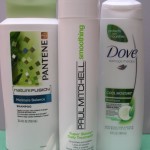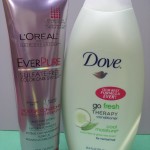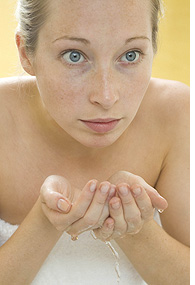Our expert offers some good advice for bad hair
by Patty Meehan

We’d all like to have that glorious hair that the models toss about in television commercials–shiny, thick and flowing, healthy-looking. Feeling good about how we look can affect our mood and our self-image: even the most natural-looking woman (or man) depends on good grooming to feel confident. That is where a good hair stylist comes in. I have been a hairdresser for more than 30 years, and I have learned a few tricks that I would like to share with you, beginning with the basics: shampoo and conditioner.
Shampoo Your ’Do
Do you wash your hair every day, once a week, several times a week? There’s no iron-clad rule about which frequency works best: it’s a personal preference and depends on how your hair looks and your scalp feels. However, I’ve found that the following routines work well for my clients and friends.
- Oily, limp hair? Shampoo every day.
- Dry, full hair? Shampoo once a week.
Consider these factors as well:
- Very active lifestyle? Shampoo every day and after vigorous activity if needed.
- Perspire a lot? You may need to shampoo more than once a day.
 When you shampoo your hair, one lathering is enough. (The first lathering gets your hair clean; a second will strip your hair of its essential oils.) When you are done shampooing, be sure to rinse the hair well to ensure that no residue of shampoo is left behind. Any residue left in the hair will eventually leave your hair dull and flat.
When you shampoo your hair, one lathering is enough. (The first lathering gets your hair clean; a second will strip your hair of its essential oils.) When you are done shampooing, be sure to rinse the hair well to ensure that no residue of shampoo is left behind. Any residue left in the hair will eventually leave your hair dull and flat.
Tip: Shampooing your hair in a deep sink makes thorough rinsing a snap!
So Many Shampoos, So Little Time!
Choosing a shampoo can be mind-boggling. There are so many options out there: shampoo for fine hair, course hair, or frizzy hair; shampoo for thinning hair, graying hair, or colored hair. The list is endless. The labels will steer you in the right direction, but you will have to try several brands to discover the best products for you.
Tip: A good cleansing shampoo without conditioner is best, because conditioning shampoo may leave your hair limp and unmanageable.
Hair products are a gamble, not a sure thing, so it is a challenge to recommend a shampoo without seeing your hair. I prefer the shampoos sold mainly in beauty supply stores or hair salons: Rene Furterer, Goldwell, and Nioxin are a few of my favorite brands.
Shampoos sold in salons range in price from about $15 to over $35 a bottle, whereas commercial brands cost less than $15. Although professional products are pricey, I find them more reliable than the less expensive shampoos sold in big-name stores.
Tip: Google it! You can often find a bargain on line. Many professional products are now available through outlets like Target.com and Amazon.com.
 There are some good commercial brands available, however, including products from L’ORÈAL, Pantene, Dove, and Paul Mitchell. The Paul Mitchell brand was a professional product for many years, and the company has managed to maintain the professional quality in its products even at the lower price point. You can usually find Paul Mitchell products and other good commercial brands at your local CVS, Duane Read, and Harmon stores.
There are some good commercial brands available, however, including products from L’ORÈAL, Pantene, Dove, and Paul Mitchell. The Paul Mitchell brand was a professional product for many years, and the company has managed to maintain the professional quality in its products even at the lower price point. You can usually find Paul Mitchell products and other good commercial brands at your local CVS, Duane Read, and Harmon stores.
Be adventurous: when you are low on shampoo, try something new. Find two or three brands that you are comfortable with and alternate them for variety.
To Condition or Not?
Most of us automatically condition after shampooing, but I don’t feel that conditioning is necessary for everyone. If you condition every time you shampoo and still find that your hair has little volume, it may be due to the conditioner. So if your hair tends to fall limply over your head, skip the conditioner and see if that makes a difference.
time you shampoo and still find that your hair has little volume, it may be due to the conditioner. So if your hair tends to fall limply over your head, skip the conditioner and see if that makes a difference.
If you think you need a conditioner, choose a product following the same steps outlined above for selecting a shampoo, and use as needed. Conditioning products vary in weight; use the lightest one that works for you. Follow these guidelines:
- Fine hair? Use a light leave-in conditioner or spray-on conditioner.
- Oily hair? Select a light, spray-on product.
- Thick or unmanageable tresses? The heavier lotion and cream conditioners are for you.
Note that a good, basic conditioner will detangle your hair. A product labeled as a “detangler” is typically lighter than a conditioner, however, and may be just right for you.
TIP: For kids, cut down on rinsing time by using detanglers or leave-in conditioners.
The weather will have an effect on your hair, too, so take that into consideration when choosing a conditioner. Dry, frizzy hair tends to be caused by a response to humidity rather than damage, so using a conditioner to control the hair’s reaction to humidity will get the best results. The outer layer of your hair is a cuticle that needs moisture and gentle care. On dry days, hair needs moisturizer; on humid days, a “de frizz” product will smooth the cuticle.
The bottom line? You need an open mind and an adventurous attitude to find what works best on your hair. If you are not satisfied with your efforts, consult a professional. The best hair stylist for you will uncover your beauty, and give you a look that will provide you with confidence, poise, and grace.
A licensed hair stylist for more than 30 years, Patty Meehan has studied her trade in London, Paris, and New York. She currently works her hairstyling magic at Joli Salon & Spa in Harrison, New York (www.salonjoli.com). In 2000, Patty took on a second career as a yoga instructor. Through both of her careers, Patty delights in helping her clients and students uncover their best selves.
Woman with beautiful hair © Shankarajn | Dreamstime.com; Shampooing illustration © Spinsugar | Dreamstime.com




 As an esthetician, I see many people who wish their skin could look better without a lot of cost and effort. To brighten your facial skin, you need to get back to the basics. The most expensive products in the world won’t work optimally unless these four simple steps are taken care of: cleansing, toning, moisturizing and, during the day, using sunscreen.
As an esthetician, I see many people who wish their skin could look better without a lot of cost and effort. To brighten your facial skin, you need to get back to the basics. The most expensive products in the world won’t work optimally unless these four simple steps are taken care of: cleansing, toning, moisturizing and, during the day, using sunscreen.